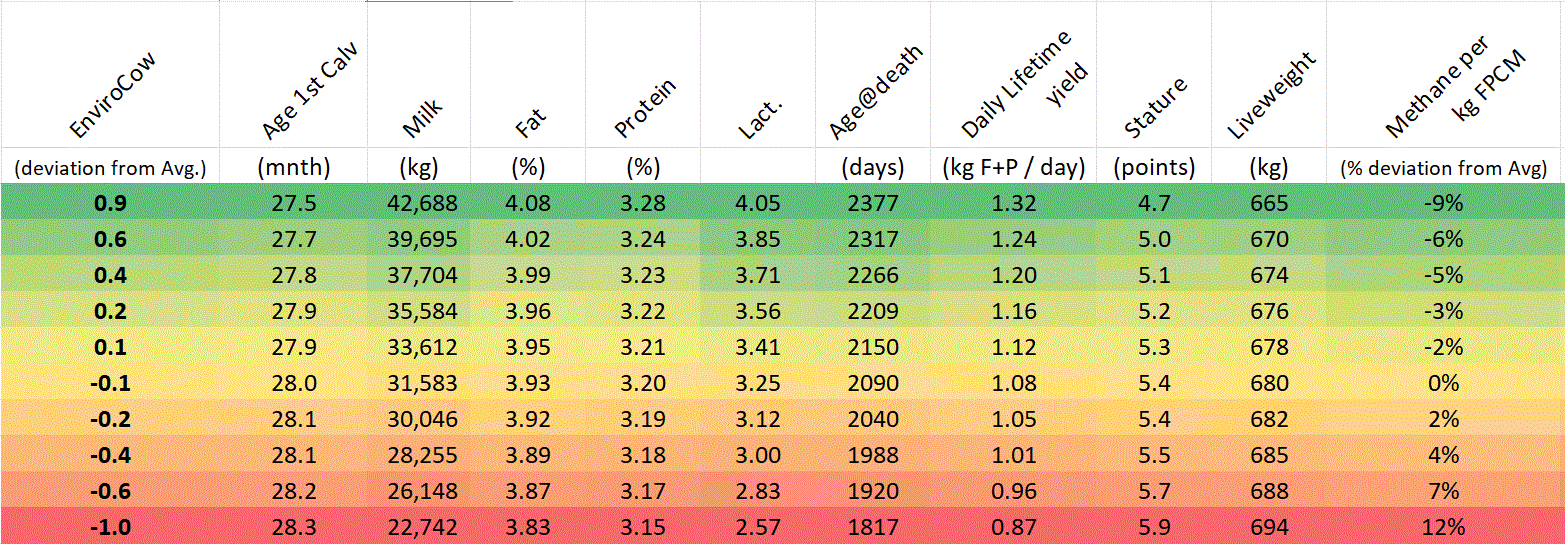It’s time to run a genetic carbon audit
Monday, 19 June 2023
Cows with a one-point higher score for EnviroCow don’t simply produce 10% less of the greenhouse gas (GHG) methane in their enteric emissions, but they also consume 10% less feed and produce a massive 33% higher weight of fat and protein in their lifetime than the average cow (see Table 1).
Without the right genetics, progress towards any performance goal will be an uphill struggle. So, it’s logical for producers to run a genetic carbon audit as part of their drive towards net zero.
Improving genetics is the cheapest and most effective way to make long-term and permanent changes to a dairy herd’s performance and new data show this is as true for carbon footprint as for any other trait that’s passed down the generations.
What is EnviroCow?
EnviroCow is a genetic index designed to help farmers breed cows with longer lifespans and improved production, fertility and feed efficiency.
It was launched by AHDB in 2021 and was the first independent genetic index in the world to focus solely on breeding cows for their environmental credentials.
Key findings
- EnviroCow shows a strong association with a range of actual recorded performance traits
- Strong links with EnviroCow include FPCM, age at first calving, mature weight and lifespan
- Cows which have high EnviroCow scores are calculated to have a lower DMI
- Top 10% EnviroCow cows are calculated to produce 21% fewer methane emissions than the bottom 10%
To check your own cows’ EnviroCow score, request a Herd Genetic Report
Table 1. Deciles (10% groups) of EnviroCow and the average lifetime performance of animals in each group, including methane production

Using EnviroCow to make dairy sire selections
This is the first time EnviroCow has been compared with cow phenotype, demonstrating the link between this environmental genetic index and cows’ actual recorded performance on the farm. And these findings give the strongest evidence yet that using EnviroCow when making dairy sire selections will help producers in their drive towards net zero while also making a worthwhile impact on their financial bottom line.
Marco Winters, Head of Animal Genetics, says:
“Until now, the impact of EnviroCow on actual performance has never been demonstrated, but now, we have analysed the national herd to see how the index is linked to real life performance and associated emissions.”
This was achieved by grouping cows according to their EnviroCow index, and then studying their phenotype – in other words, how they appeared or performed on the farm.
Traits across the 475,000 cows studied* that were of particular interest included:
- Yields of fat and protein correct milk (FPCM) over their lifetimes
- Age at first calving (AFC)
- Number of lactations
- Mature weight (derived from proxies as liveweight itself is not routinely recorded)
- Stature (where available)
These are all traits that are known to influence dry matter intake (DMI), whether that intake is partitioned to growth, maintenance or production.
DMI in turn is proven to affect enteric methane production – in other words, the emissions produced directly through microbial fermentation in the rumen.
Using published values which relate DMI to enteric emissions, it is possible to predict the total emissions from each animal.
“For instance, a high replacement rate, heavy mature liveweight or a delayed AFC will all impact lifetime emissions through the amount of feed required for rearing,” says Mr Winters.
"Similarly, higher yields of FPCM will also increase total emissions due to higher feed requirements, but these will dilute the environmental cost of replacements and maintenance feed over an animal’s lifetime, so reducing emissions on a per kg FPCM basis.”
The outcome is shown in the table, which groups cows by their genetic index for EnviroCow and then indicates their recorded performance for a range of traits. It also shows their projected enteric methane production expressed as a deviation from the average (mean).
“The table shows clearly how well EnviroCow is working as the top 10% cows with the best (highest) score for EnviroCow produce the least methane for each kg of FPCM,” he says.
The reason they have a low environmental footprint per litre is because these higher EnviroCow index cows have, on average, higher lifetime yields of FPCM, a younger AFC, more lactations and longer lifespans, and so offer an excellent combination of traits required for efficient dairy production.
“The fact that these cows were also of a smaller stature and lower liveweight is no surprise at all, as they weren’t bearing the high maintenance costs associated with bigger animals,” he says.
The bottom row in the table, showing cows with the worst 10% EnviroCow scores, is a stark demonstration of just how inefficient and polluting these are compared to the best genetics.
This group has, on average, the tallest, heaviest cows with a late AFC and a shorter lifespan. These animals lasted just 2.57 lactations, on average, and are projected to produce 12% more methane than average per kg FPCM.
“Any herd which calculates a carbon footprint for its milk buyer will find that these are the cows which knock their score down,” he observes.
However, although enteric emissions of methane are the largest contributor of greenhouse gases in dairy farming – accounting for around 45% of total farm emissions – they are only part of the picture.
“It’s not unreasonable to assume that cows which eat less are also indirectly affecting a farm’s total carbon footprint to the same degree through a variety of other factors,” he says. “This includes the smaller amount of feed bought or grown which bears its own carbon footprint, whether through fertiliser, fuel or other factors, and the smaller amount of manure and its associated emissions, from these higher EnviroCow rated animals.
“It’s a very reassuring picture that has been revealed but it doesn’t come as any surprise,” he concludes. “EnviroCow is performing exactly as intended but the fact that we’ve now seen the extent of the benefits in practice will hopefully encourage producers to make sure they select their service sires with a high score for this index.”
*The cows studied had to have a death date for their actual lifespan and lifetime yields to be known. Therefore, cows born between 2008 and 2011 were used in the study. These years were chosen for being both the most representative of today’s herd and having a death date.
Any remaining alive within this cohort – because of their long lifespans – could not be included in the dataset but are likely to strengthen the positive links between EnviroCow and actual emissions which have been demonstrated.
Source: The EnviroCow index and its impact on the UK dairy industry’s carbon footprint
Find out more about EnviroCow and predicted transmitting abilities (PTAs)


